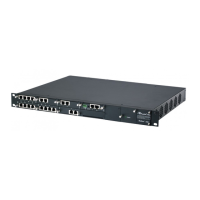SIP User's Manual 264 Document #: LTRT-83310
Mediant 600 & Mediant 1000
Parameter Description
Notes:
The value -1 indicates that it is ignored in the rule.
This parameter is applicable only to the IP-to-IP application.
Web/EMS: Destination
Prefix
Destination (called) telephone number prefix. An asterisk (*) represents
any number.
Web/EMS: Redirect Prefix Redirect telephone number prefix. An asterisk (*) represents any
number.
Web: Stripped Digits From
Left
EMS: Remove From Left
Number of digits to remove from the left of the telephone number prefix.
For example, if you enter 3 and the phone number is 5551234, the new
phone number is 1234.
Web: Stripped Digits From
Right
EMS: Remove From Right
Number of digits to remove from the right of the telephone number
prefix. For example, if you enter 3 and the phone number is 5551234,
the new phone number is 5551.
Web/EMS: Prefix to Add The number or string that you want added to the front of the telephone
number. For example, if you enter '9' and the phone number is 1234,
the new number is 91234.
Web/EMS: Suffix to Add The number or string that you want added to the end of the telephone
number. For example, if you enter '00' and the phone number is 1234,
the new number is 123400.
Web/EMS: Number of
Digits to Leave
The number of digits that you want to retain from the right of the phone
number.
Web: Presentation
EMS: Is Presentation
Restricted
Determines whether Caller ID is permitted:
Not Configured = Privacy is determined according to the Caller ID
table (see Configuring Caller Display Information on page 327).
[0] Allowed = Sends Caller ID information when a call is made using
these destination/source prefixes.
[1] Restricted = Restricts Caller ID information for these prefixes.
Note: If 'Presentation' is set to 'Restricted' and the AssertedIdMode
parameter is set to 'P-Asserted', then the From header in the INVITE
message includes the following: From: 'anonymous' <sip:
anonymous@anonymous.invalid> and 'privacy: id' header.
18.3.5 Mapping NPI/TON to SIP Phone-Context
The Phone-Context Table page allows you to map Numbering Plan Indication (NPI) and
Type of Number (TON) to the SIP Phone-Context parameter. When a call is received from
the ISDN/Tel, the NPI and TON are compared against the table and the matching Phone-
Context value is used in the outgoing SIP INVITE message. The same mapping occurs
when an INVITE with a Phone-Context attribute is received. The Phone-Context parameter
appears in the standard SIP headers where a phone number is used (Request-URI, To,
From, Diversion).
For example, for a Tel-to-IP call with NPI/TON set as E164 National (values 1/2), the
device sends the outgoing SIP INVITE URI with the following settings:
“sip:12365432;phone-context= na.e.164.nt.com“. This is configured for entry 3 in the figure
below. In the opposite direction (IP-to-Tel call), if the incoming INVITE contains this Phone-
Context (e.g. "phone-context= na.e.164.nt.com"), the NPI/TON of the called number in the
outgoing SETUP message is changed to E164 National.

